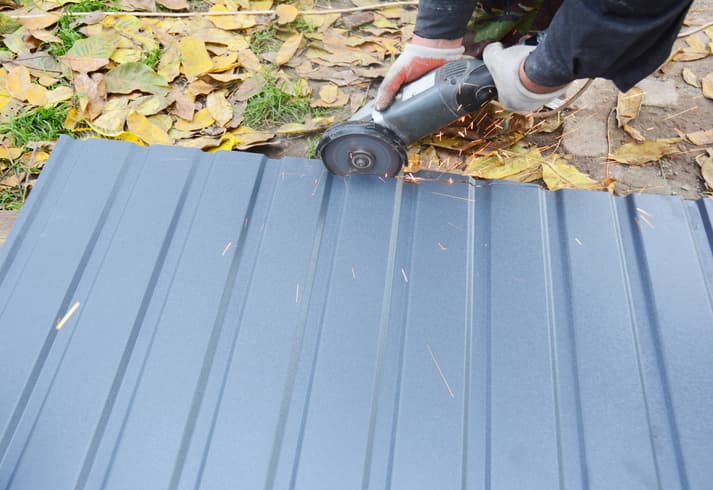Roofing
How to cut metal roofing: A Comprehensive Guide
How to cut metal roofing? Metal roofing is a popular choice for homeowners, offering durability and longevity. However, cutting metal roofing requires precise techniques and the right tools.
In this comprehensive guide, we’ll take you through the process step by step, covering essential tools, safety measures, and expert tips to help you achieve a professional result.
I. Understanding Metal Roofing Materials
Metal roofing materials come in various types such as aluminum, steel, and copper, each with different thicknesses. Understanding these materials is crucial before you begin your project, as it impacts the cutting methods you should use.
A. Aluminum Roofing:
- Properties: Lightweight, resistant to corrosion, suitable for coastal areas.
- Cautions: While aluminum is corrosion-resistant, it can still experience wear and tear over time. Ensure proper coatings and maintenance to enhance longevity.
B. Steel Roofing:
- Properties: Durable, available in various coatings for rust resistance, affordable.
- Cautions: Steel roofing can rust if the protective coating is damaged. Regular inspections and timely repairs are essential to prevent corrosion.
C. Copper Roofing:
- Properties: Elegant appearance, excellent conductivity, develops a unique patina over time.
- Cautions: Copper is expensive and can be prone to theft. Secure your roofing materials and consider insurance coverage.
D. Other Metal Roofing Materials:
- Properties: Some other materials include zinc, tin, and alloys.
- Cautions: Research the specific properties of less common metals. Some may require special handling or maintenance.
E. Metal Thickness and Gauge:
- Properties: Metal thickness is measured in gauges, with lower gauges indicating thicker metal.
- Considerations: Thicker gauges offer more durability but can be harder to cut. Thinner gauges are easier to cut but may be less durable. Choose an appropriate gauge for your project’s needs.
F. Environmental Impact:
- Properties: Metal roofing is recyclable and eco-friendly.
- Considerations: Ensure proper disposal of old roofing materials. Opt for recycled metal roofing if you want an environmentally conscious choice.
G. Budget Considerations:
- Properties: Metal roofing comes in a wide price range, allowing for budget flexibility.
- Considerations: Balance quality and cost. Cheaper options may compromise durability and longevity, leading to higher maintenance costs in the long run.
H. Weather and Climate Considerations:
- Properties: Metal roofing is durable and can withstand various weather conditions.
- Cautions: In areas prone to extreme weather, ensure proper insulation to prevent condensation and temperature-related issues inside the house.
II. Compatibility with Other Roofing Materials:
- Properties: Metal roofing can be compatible with other materials like asphalt shingles.
- Considerations: Consult with a roofing professional to ensure compatibility and proper installation techniques when combining metal roofing with other materials.
Understanding the properties and considerations of different metal roofing materials is essential for a successful roofing project.
Always consult with professionals conduct thorough research before making any decisions, and ensure regular maintenance to prolong the lifespan of your metal roofing.
III. Essential Tools for Cutting Metal Roofing
To cut metal roofing effectively and safely, it’s essential to have the right tools on hand. Here’s a detailed overview of the necessary tools and equipment, along with cautions and considerations for each:
1. Metal Sheets:
- Properties: Metal roofing sheets come in various materials and thicknesses.
- Cautions: Handle metal sheets with care to avoid sharp edges. Wear gloves while handling to prevent cuts.
2. Snips, Shears, and Saws:
- Properties: Snips are versatile cutting tools, shears are suitable for straight cuts, and saws provide efficient cutting for thicker metal.
- Cautions: Keep blades sharp for clean cuts. Avoid applying excessive force, which can lead to uneven cuts or blade damage.
3. Nibbler:
- Properties: Nibblers are ideal for cutting intricate patterns and curves in metal roofing.
- Cautions: Use nibblers cautiously, as they can be challenging to control. Practice on scrap metal before attempting intricate cuts on roofing sheets.
4. Blades:
- Properties: High-quality blades designed for metal cutting provide clean and precise cuts.
- Cautions: Blades can become hot during prolonged use. Allow them to cool down before touching. Replace dull blades to avoid jagged cuts.
5. Guidelines:
- Properties: Guidelines or markings ensure accurate measurements and cuts on metal sheets.
- Considerations: Double-check measurements before cutting to avoid wastage. Use a straight edge or ruler to create precise guidelines.
6. Safety Gear:
- Properties: Safety gear includes gloves, goggles, and ear protection.
- Cautions: Always wear safety gear to protect against sharp metal edges, flying debris, and loud noises. Replace damaged safety gear promptly.
7. Consideration for Power Tools:
- Properties: Power tools like electric shears and angle grinders can provide efficient cutting for large projects.
- Cautions: Proper training is essential for using power tools safely. Follow manufacturer instructions and wear appropriate safety gear. Be cautious of the heat generated by power tools during operation.
8. Storage and Maintenance:
- Properties: Proper storage and maintenance prolong the lifespan of cutting tools.
- Considerations: Store tools in a dry, cool place to prevent rust. Regularly clean, oil, and sharpen blades to ensure optimal performance.
9. Environmental Impact:
- Properties: Some cutting tools may have environmental considerations.
- Cautions: Dispose of used blades and worn-out tools responsibly. Some materials may be recyclable, so check local recycling programs.
Having the right tools and understanding their proper usage is essential for cutting metal roofing effectively.
Always prioritize safety, follow manufacturer guidelines, and consider professional assistance for large or complex projects.
Regular maintenance of tools ensures their longevity and efficiency.
IV. Safety Measures
Ensuring safety during metal roofing projects is paramount. By following proper safety measures, you can prevent accidents and injuries.
Here’s a detailed overview of the safety precautions to take, including cautions and considerations:
Safety Gear:
- Properties: Safety gear includes gloves, goggles, and ear protection.
- Cautions: Wear gloves made of cut-resistant material to protect hands from sharp edges. Goggles shield your eyes from metal shards, and ear protection guards against loud noises from cutting tools.
Proper Ventilation:
- Properties: Proper ventilation prevents the buildup of fumes and gases.
- Cautions: When cutting metal roofing, especially with power tools, ensure good ventilation to disperse fumes and prevent inhalation of harmful substances.
Sturdy Work Surface:
- Properties: A stable work surface ensures safety and precision.
- Cautions: Avoid working on uneven or shaky surfaces, as they can lead to accidents and inaccurate cuts. Use sawhorses or a stable platform for support.
Fire Safety:
- Properties: Metal cutting can create sparks, posing a fire risk.
- Cautions: Keep a fire extinguisher nearby and clear the workspace of flammable materials. Avoid cutting near gas lines or other potential sources of ignition.
Electrical Safety:
- Properties: Power tools require electricity, posing electrical hazards.
- Cautions: Use tools with grounded plugs and proper extension cords. Inspect cords for damage and replace them if necessary. Keep cords away from water and sharp edges.
Handling Tools Safely:
- Properties: Proper handling of cutting tools ensures safe operation.
- Cautions: Read and follow the manufacturer’s instructions for all tools. Avoid carrying tools by the cord, and always disconnect power sources when changing blades or performing maintenance.
Sharp Tool Awareness:
- Properties: Sharp cutting tools are essential for clean cuts.
- Cautions: Be cautious when handling sharp blades. Store them properly when not in use, and never leave them unattended. Dispose of used blades in a designated container.
Caution with Power Tools:
- Properties: Power tools provide efficient cutting but require careful handling.
- Cautions: Use power tools only if you are trained and experienced. Follow safety guidelines and wear appropriate safety gear. Keep hands away from moving parts, and disconnect power when changing accessories.
Emergency Preparedness:
- Properties: Emergency preparedness ensures a quick response to accidents.
- Cautions: Have a first aid kit and emergency contact numbers readily available. Familiarize yourself with the location of the nearest medical facility in case of severe injuries.
Professional Assistance:
- Properties: Hiring professionals for complex projects ensures safety and quality.
- Considerations: If you are unsure about any aspect of metal roofing or cutting, seek professional assistance. DIY projects are rewarding, but safety should always be the top priority.
By prioritizing safety, understanding the risks involved, and taking necessary precautions, you can ensure a secure environment for your metal roofing project.
Always follow safety guidelines and be aware of your surroundings to prevent accidents and injuries.
V. Step-by-Step Guide to Cutting Metal Roofing
Understanding the step-by-step process of cutting metal roofing is essential for a successful and safe project. Here’s a detailed guide, along with cautions and considerations for each step:
Prepare Your Work Area:
- Properties: A clean and stable workspace is essential for precision and safety.
- Cautions: Clear the area of debris and potential tripping hazards. Ensure a stable work surface, preferably using sawhorses or a similar support structure. Keep the work area well-lit to avoid accidents.
Measure and Mark:
- Properties: Accurate measurements and markings are crucial for precise cuts.
- Cautions: Double-check measurements before making any cuts to avoid wastage. Use a straight edge or ruler to create precise guidelines. Markings should be clear and visible, ensuring accurate cutting.
Choose the Right Tool:
- Properties: Different tools are suited for various metal thicknesses and cutting techniques.
- Cautions: Select the appropriate tool based on the metal’s thickness and your project requirements. Using the wrong tool can result in uneven cuts or damage to the material. Be mindful of the tool’s limitations.
Cutting Techniques:
- Properties: Different techniques are used for straight cuts, curved cuts, and intricate patterns.
- Cautions: Practice cutting techniques on scrap metal before attempting intricate patterns on roofing sheets. For curved cuts, go slowly and steadily to maintain control. For intricate patterns, be patient and precise to avoid mistakes.
Safety First:
- Properties: Safety gear is crucial during the cutting process.
- Cautions: Always wear gloves, goggles, and ear protection to protect against sharp metal edges, flying debris, and loud noises. Avoid wearing loose clothing that could get caught in tools. Keep hands and body parts away from cutting edges to prevent injuries.
Clean Up:
- Properties: Proper clean-up ensures a safe work environment.
- Cautions: Clean up metal shavings and debris promptly to prevent accidents. Dispose of waste materials responsibly. Store tools in a designated area after use to prevent tripping hazards.
Special Considerations for Power Tools:
- Properties: Power tools provide efficient cutting but require careful handling.
- Cautions: When using power tools, maintain a firm grip and use a stable stance. Be cautious of the heat generated during operation. Disconnect power sources before changing accessories or blades. Store power tools safely to prevent damage.
Regular Maintenance:
- Properties: Regular maintenance ensures tools function correctly.
- Cautions: Clean, oil, and sharpen blades regularly to ensure optimal performance. Replace damaged or worn-out blades promptly. Store tools in a dry, cool place to prevent rust.
By following these step-by-step guidelines and exercising caution at every stage, you can ensure accurate, safe, and efficient metal roofing cuts.
Practice proper techniques, prioritize safety, and maintain your tools for a successful metal roofing project. Always seek professional assistance if you are uncertain about any aspect of the cutting process.
Explore top-rated metal roofing cutting tools and accessories at [Affiliate Tool Shop]. Their expert-selected products ensure efficiency and safety for all your projects.
VI. Metal Roofing Installation and Cutting
Properly integrating cut metal roofing sheets into your roofing structure is crucial for a secure and durable installation. Here’s a detailed guide, along with cautions and considerations for metal roofing installation and cutting:
Proper Alignment and Placement:
- Properties: Correct alignment ensures a seamless roofing structure.
- Cautions: Align cut metal roofing sheets accurately to avoid gaps or overlaps. Inaccurate placement can lead to leaks and compromised structural integrity.
Fastening Techniques:
- Properties: Various fastening methods secure metal roofing sheets to the structure.
- Cautions: Use appropriate fasteners recommended by the manufacturer. Over-tightening screws can damage the metal, while under-tightening can lead to loose sheets during strong winds.
Sealing and Weatherproofing:
- Properties: Proper sealing prevents water infiltration and enhances weather resistance.
- Cautions: Apply sealant in areas vulnerable to water penetration, such as seams and joints. Ensure the sealant is compatible with the metal material to prevent corrosion.
Expansion and Contraction Considerations:
- Properties: Metal roofing expands and contracts with temperature variations.
- Cautions: Allow for expansion gaps during installation to accommodate thermal movement. Failure to account for expansion can cause warping and buckling of metal sheets.
Insulation and Condensation Prevention:
- Properties: Proper insulation prevents condensation and regulates indoor temperature.
- Cautions: Insulate the roofing structure adequately to prevent condensation buildup, especially in colder climates. Improper insulation can lead to moisture-related issues and reduced energy efficiency.
Flashing Installation:
- Properties: Flashing directs water away from vulnerable areas.
- Cautions: Install flashing around chimneys, vents, and other openings. Improper flashing installation can lead to leaks. Use appropriate flashing materials compatible with the metal roofing to prevent corrosion.
Regular Inspections:
- Properties: Regular inspections ensure the roof’s integrity over time.
- Cautions: Schedule periodic inspections to identify potential issues such as loose fasteners, damaged sealant, or signs of corrosion. Address issues promptly to prevent extensive damage.
Caution with Roofing Accessories:
- Properties: Accessories such as skylights and solar panels require careful integration.
- Cautions: Follow manufacturer guidelines when integrating accessories with metal roofing. Improper installation can compromise the roof’s integrity and lead to leaks or structural damage.
Professional Assistance:
- Properties: Professionals ensure proper installation and integration of metal roofing.
- Considerations: If you are unsure about any aspect of metal roofing installation or cutting, seek professional assistance. Proper installation is essential for the roof’s longevity and performance.
By paying attention to these installation considerations and exercising caution, you can ensure a watertight, durable, and aesthetically pleasing metal roofing structure.
Regular maintenance and professional assistance, when needed, are key to a successful and long-lasting metal roofing installation.
VII. Tips for Enhancing Metal Roofing Skills
Enhancing your metal roofing skills goes beyond the cutting and installation process. It involves continuous learning, proper maintenance, and knowing when to seek professional assistance.
Here’s a detailed guide, along with cautions and considerations for improving your expertise in metal roofing:
Practice Proper Maintenance:
- Properties: Regular maintenance prolongs the life of your metal roofing.
- Cautions: Check for loose fasteners, damaged sealant, or signs of corrosion during maintenance checks. Address issues promptly to prevent further damage. Be cautious when walking on metal roofing to avoid denting or bending.
Continuous Learning:
- Properties: Metal roofing techniques and materials evolve over time.
- Cautions: Stay updated with the latest industry trends, tools, and techniques through online resources, workshops, and professional forums. Exercise caution when experimenting with new techniques, ensuring they align with industry standards.
Professional Assistance:
- Properties: Professionals offer expertise for complex projects.
- Cautions: DIY enthusiasts should know their limitations. If a project requires specialized knowledge or equipment, consult or hire a professional. Attempting complex tasks without proper expertise can lead to costly mistakes.
Explore Energy-Efficient Options:
- Properties: Metal roofing can be integrated with energy-efficient solutions.
- Cautions: When installing energy-efficient additions like solar panels, ensure they are compatible with metal roofing systems. Improper installation can compromise the roof’s integrity and lead to leaks.
Environmentally Conscious Choices:
- Properties: Metal roofing is recyclable and eco-friendly.
- Cautions: Dispose of old roofing materials responsibly. Consider recycled metal roofing options to reduce environmental impact. Be aware of local recycling programs and regulations.
Engage in DIY Communities:
- Properties: DIY communities provide valuable insights and support.
- Cautions: Verify information obtained from online communities with reputable sources. While DIY forums can offer useful tips, exercise caution and critical judgment to ensure the accuracy and safety of the advice received.
Safety First:
- Properties: Safety precautions are essential in all metal roofing tasks.
- Cautions: Regardless of skill level, always prioritize safety. Even experienced individuals can face accidents if proper precautions are not taken. Revisit safety guidelines regularly and reinforce safe practices.
Document and Learn from Mistakes:
- Properties: Documenting mistakes can lead to valuable learning experiences.
- Cautions: When a mistake occurs, analyze the cause and document it. Learning from mistakes is crucial for skill enhancement. However, avoid repeating the same errors; apply lessons learned to future projects.
By adhering to these tips and exercising caution, you can enhance your metal roofing skills effectively.
Continuous learning, attention to safety, and the willingness to seek professional help when needed are key factors in becoming proficient in metal roofing projects.
Remember that ongoing education and a proactive approach to maintenance are essential for mastering the art of metal roofing.
Enhance your metal roofing skills with advanced techniques and expert guidance at [Affiliate Roofing Academy]. Their online courses offer in-depth knowledge and hands-on training for DIY enthusiasts and professionals.
Conclusion
Cutting metal roofing demands precision, expertise, and the right tools. By following our comprehensive guide and prioritizing safety, you can achieve a successful metal roofing project.
Continuous learning and seeking professional assistance, when needed, are key to mastering the art of cutting metal roofing.
Frequently Asked Questions(FAQ’s)
Q: What is the best way to cut metal roofing?
A: The best way to cut metal roofing is by using specialized cutting tools such as electric shears, nibblers, or a circular saw with a metal-cutting blade.
For example, electric shears are handheld tools designed specifically for cutting metal roofing sheets.
They provide clean, straight cuts and are relatively easy to control, making them a popular choice among professionals and DIY enthusiasts.
Q: What is the best tool to cut corrugated metal?
A: The best tool to cut corrugated metal is electric shears or nibblers. Electric shears are efficient handheld tools designed for cutting through corrugated metal sheets.
Nibblers, on the other hand, are small cutting tools that can handle intricate curves and shapes in corrugated metal. Both tools provide precise cuts without causing damage to the corrugations.
Q: Can you cut metal roofing with a skilled saw?
A: Yes, you can cut metal roofing with a skilled saw, but you need a metal-cutting blade specifically designed for this purpose.
For example, a skilled saw equipped with a carbide-tipped metal-cutting blade can make clean and accurate cuts in metal roofing materials.
Ensure the blade is suitable for metal cutting to prevent overheating and warping of the material.
Q: How to cut metal easily at home?
A: To cut metal easily at home, use the appropriate tools such as electric shears, nibblers, or a circular saw with a metal-cutting blade.
For example, a circular saw with a metal-cutting blade is versatile and can handle various metal-cutting tasks.
It’s essential to secure the metal sheet properly, wear safety gear, and follow proper cutting techniques to ensure ease and precision.
Q: How to cut metal roofing with a circular saw?
A: To cut metal roofing with a circular saw, use a high-quality metal-cutting blade suitable for the specific metal material.
For example, a carbide-tipped circular saw blade is excellent for cutting through metal roofing sheets. Secure the metal sheet, wear safety gear, and guide the saw along the cutting line for precise and efficient cuts.
Q: How to cut metal roofing with an angle grinder?
A: To cut metal roofing with an angle grinder, attach a metal-cutting disc to the grinder. For example, a cutting disc made of abrasive material is suitable for metal cutting tasks.
Secure the metal sheet, wear safety gear, and carefully guide the angle grinder along the cutting line. Exercise caution to prevent overheating and ensure accurate cuts.
Q: How to cut metal roofing by hand?
A: To cut metal roofing by hand, use tin snips, aviation snips, or compound snips designed for metal cutting.
For example, compound snips have multiple pivot points, allowing for easy cutting through metal sheets.
Mark the cutting line, wear safety gear, and make steady, controlled cuts along the guideline using the appropriate snips. It requires physical effort and precision.
Q: How do professionals cut metal roofing?
A: Professionals use specialized tools such as electric shears, nibblers, or circular saws with metal-cutting blades to cut metal roofing.
For example, electric shears provide clean and precise cuts, while circular saws equipped with metal-cutting blades offer versatility for various metal cutting tasks.
They follow proper safety protocols, precise measurements, and expert techniques to ensure high-quality cuts.
Q: How to cut metal siding?
A: Metal siding can be cut using electric shears, nibblers, circular saws with metal-cutting blades, or angle grinders.
For example, electric shears provide efficient cutting for straight lines, while nibblers are ideal for intricate cuts. Circular saws equipped with metal-cutting blades offer versatility, and angle grinders with cutting discs are suitable for shaping and detailed cuts.
Secure the siding, wear safety gear, and choose the appropriate tool based on the specific metal siding material and cutting requirements.
Q: How to cut metal roofing with tin snips?
A: To cut metal roofing with tin snips, mark the cutting line and use the snips to make steady, controlled cuts along the guideline.
For example, compound snips with serrated edges provide better grip and control when cutting metal roofing sheets. Wear safety gear, apply consistent pressure, and follow the cutting line accurately for clean and precise cuts.
Q: What kind of blade to cut metal roofing?
A: To cut metal roofing, use a carbide-tipped circular saw blade specifically designed for metal cutting.
For example, a carbide-tipped blade with sharp teeth and the appropriate tooth geometry ensures efficient and smooth cuts through metal roofing sheets.
Choose a blade suitable for the specific metal material and thickness to achieve precise and accurate results.
Q: How to cut metal roofing lengthwise?
A: To cut metal roofing lengthwise, use a circular saw with a metal-cutting blade or electric shears.
For example, a circular saw equipped with a carbide-tipped metal-cutting blade provides straight and accurate lengthwise cuts.
Secure the metal sheet, wear safety gear, and guide the saw or shears along the cutting line for precise lengthwise cuts.
Ensure the cutting tool is suitable for the metal material and thickness to achieve optimal results.
Recent Posts
- How to Cut Metal Roofing: A Comprehensive Guide
- What is rolled roofing: A Comprehensive Guide
- How to Shingle a Hip Roof: A Step-by-Step Installation Guide
- How Long Does A Thatched Roof Last: The Ultimate Guide
- Tile Roof Repair: Tips and Techniques. The Ultimate Guide




